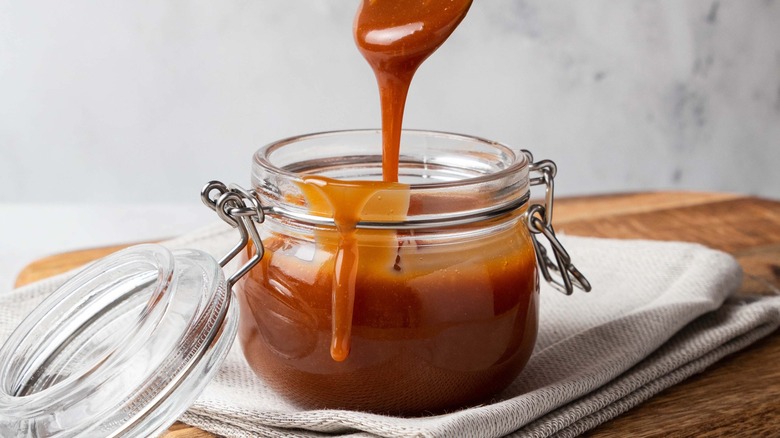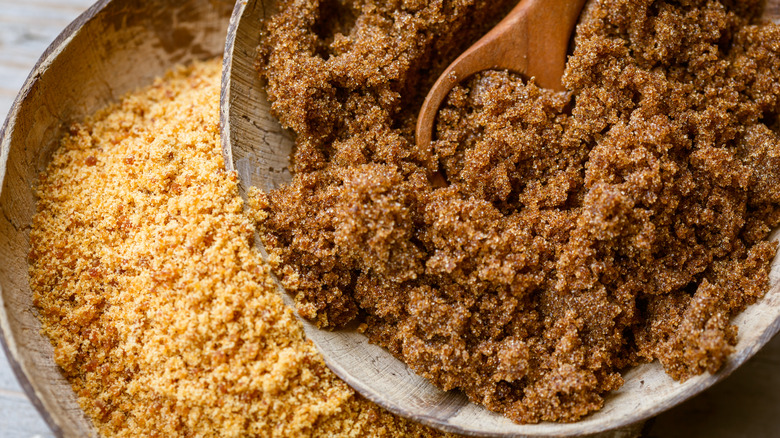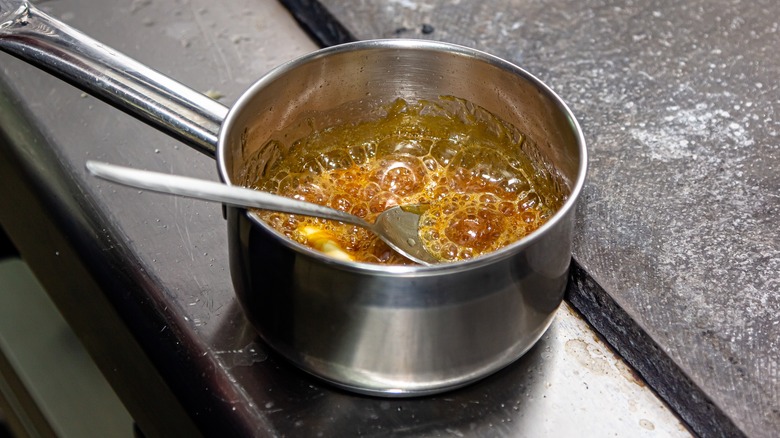Caramel And Butterscotch Have One Sugary Difference
Both caramel and butterscotch are perfectly sweet, syrupy, and warm additions to any dessert. The two confections could easily be mistaken for twins. However, there is one key difference that sets the two sauces apart, and understanding their differences can help you make the most of both.
Caramel, the more iconic of the two, is made by heating up white sugar, either with water or on its own, until the sugar browns and liquifies, turning a deep, almost brown color. Caramel is quite versatile, as it's used for sauces, hard candies, and chews. Adding ingredients such as milk or butter can also transform caramel into soft candy or syrup.
Meanwhile, butterscotch is often associated with pudding cups and those hard candies found at the bottom of so many grandmothers' purses. Indeed, butterscotch is perhaps a little less understood and admired than caramel, but the real difference between butterscotch and caramel is that butterscotch is made from brown sugar rather than white sugar. Also, unlike caramel, butterscotch includes butter by default, making butterscotch more complex than the simple sugary caramel.
What a difference molasses makes
While caramel uses white sugar, butterscotch uses brown sugar. But what exactly is brown sugar? According to Food Insight, brown sugar is made from sugar beets or sugar cane and is then combined with molasses syrup. The process is simple enough that you can do it at home by adding molasses syrup to boiling sugar or by adding molasses to table sugar.
Often overlooked by modern bakers, molasses is a dark brown sugar syrup that has an incredibly sticky and thick consistency. It's created during the sugar refinement process and ranges in color from light to an incredibly, extra concentrated version called blackstrap. The color of molasses indicates its sweetness and depth of flavor. In general, the lighter the molasses, the sweeter it is, while darker molasses is less sweet, and features a more intense flavor that can even be bitter.
Molasses is the reason brown sugar has a deeper, richer flavor than regular white sugar, and its dynamic nature, results in the variations in intensity and flavor between light and dark brown sugars. Eventually, this intensity and depth of flavors appears in butterscotch too.
Letting butterscotch shine
The difference between caramel and butterscotch may seem relatively small, but small things matter. For one, though caramel has a shorter list of ingredients, it can be much more difficult to create at home compared with butterscotch. Making caramel comes with a myriad of risks and pitfalls, including burning, seizing, and splitting. And while you can mess up butterscotch, it's much more difficult. But what makes butterscotch so much easier to master? Once again, the answer is brown sugar.
Brown sugar is more acidic than white sugar, and because it's made with molasses, it contains more moisture, making it less likely to seize or crystallize. On top of all this, the butter that is added to butterscotch but left out of caramel, helps the sugar crystals to dissolve more easily. Of course, butterscotch does come with its own challenges, but it is an easier place to start for any baker intimidated by caramel.
This is not to say that butterscotch is a stand-in for caramel, or vice versa. Though caramel is a lot fussier to make than butterscotch, it is infinitely more adaptable. Your standard caramel, made with just one basic element, sugar, can easily be jazzed up with the addition of butter, cream, or even salt. Meanwhile, butterscotch's warm, brown sugar taste can feel stuffy and stuck in the past, but it's also its biggest asset. Though less malleable than caramel, butterscotch's distinctive flavor makes it robust enough to hold its own in a variety of desserts. In the end, the distinctions that set butterscotch and caramel apart are small but important, because whether you prefer butterscotch or caramel there's a place for both in your kitchen and on your desserts.


